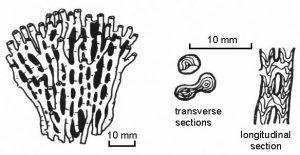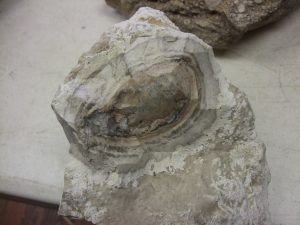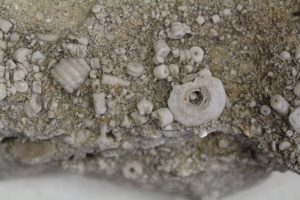
We would hazard a guess that if you were to ask a class of students which part of the Litzsinger Road Ecology Center was their favorite, most would say the creek. While humans tend to be drawn to water, the rocks and fossils at Deer Creek are another big part of the attraction. Next time you are at the creek, take a few minutes to look at the rocks around your feet–you never know what you might find!
- During which geologic era was most of the bedrock at LREC formed?
- Jurassic
- Devonian
- Pennsylvanian
- Mississippian
- Cretaceous
- What kind of rock forms the bedrock at LREC?
- Pumice
- Limestone
- Granite
- Shale
- Chert
- Match the fossil images to their names. All of these fossils are commonly found at LREC.
Answers
- d) Mississippian. The Mississippian Period occurred about 300-340 million years ago. The Mississippian Period was part of the Paleozoic Era. During this time, the land beneath us was closer to the equator and covered with a warm sea.
- b) Limestone. Limestone forms when sediment, shells, and other marine organisms settle to the sea floor. With time and pressure, the sediment becomes rock. This is why limestone is an excellent place to find fossils of sea creatures. Technically, much of our limestone has turned to dolostone through chemical processes, but the fossils remain.
- Matching
- Crinoids=image v. Crinoids (sea lilies) are the state fossil of Missouri. They are animals related to sea stars and display the same five-part radial symmetry. The round pieces commonly found at LREC were sections of the stalk that supported a flower-like set of arms that trap food floating by. Although many modern crinoids move freely and do not have functional stalks, some do and look very much like the ones fossilized millions of years ago.

Living crinoids. Photo: NOAA Photo Library - Tabulate coral=image i. Tabulate coral fossils found at LREC are often recognizable by large cylindrical holes with small volcano-looking mounds at the bottom. Sometimes you find the mini-volcanoes without their surrounding cylinders. Ancient corals were much like modern corals and built up rocky cases around themselves for protection. The mounds at the bottom of the holes are the fossilized remains of the base of the coral animal. As the coral grew, it would create a new chamber for itself above its old chamber. In the image above, you can see a sideways coral, showing the bumpy side of the tube where chambers had been built on top of chambers over the years.

Tabulate coral creating new living chambers. Image from Kentucky Geological Survey. - Brachiopods=image iii. Brachiopods (lamp shells) have two shells (called valves) that are of unequal size—the pedicle valve is larger than the brachial valve. A fleshy stem, called a pedicle, comes out near the hinge of the valves and anchors the animal to a rock or the sea floor. Although they look like mussels, clams, and other mollusks, brachiopods are not related to mollusks. Next time you are in the cabin, take a look at our rock with many brachiopod fossils in it. See if you can find where the soft innards of one of the brachiopods fossilized and crystallized.
- Chert nodule=image ii. Chert nodule—which is not a fossil—the state rock of Missouri is a type of chert called mozarkite, and is one of the most abundant rocks in Missouri. Chert comes in a variety of colors and patterns and is made up mostly of the mineral silica from the accumulation of tiny marine animals and sponges which secreted particles of silica. Chert forms as nodules created through filling spaces in existing limestone, or possibly through the formation of layers of sedimentary rock at the same time limestone was being formed. Most of the chert we find along Deer Creek are bits and pieces of the nodules.
- Pipe organ coral=image iv. Pipe organ coral is a type of tabulate coral, always lived in colonies. They consisted of a group of vertical tubes called coralites that were connected by small horizontal tubes.
- Crinoids=image v. Crinoids (sea lilies) are the state fossil of Missouri. They are animals related to sea stars and display the same five-part radial symmetry. The round pieces commonly found at LREC were sections of the stalk that supported a flower-like set of arms that trap food floating by. Although many modern crinoids move freely and do not have functional stalks, some do and look very much like the ones fossilized millions of years ago.

Thank you to Scott George for sharing his geological knowledge with us on multiple occasions. We drew heavily from his information for this quizz, and you can download one of his presentations from our website.




